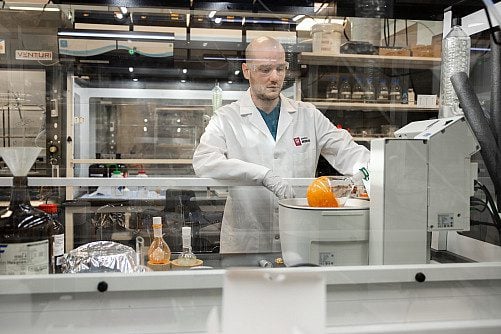Researchers have found new targets that could lead to better treatments for Alzheimer’s disease.
The findings come from the Target Enablement to Accelerate Therapy Development for Alzheimer’s Disease (TREAT-AD) center, a multi-institution effort launched in 2019 to expand the pipeline of potential Alzheimer’s therapies. The center is led by IU and includes partners at Purdue University, the Indiana Biosciences Research Institute (IBRI), Lgenia Inc. and the University of Pittsburgh.
Over the past six years, TREAT-AD has focused on identifying proteins in the brain’s immune cells, known as microglia, that play a role in the disease. From hundreds of initial possibilities, researchers narrowed the list to 30 targets, then concentrated on five with the strongest potential for new drug development.
“What has been collectively accomplished across the IU School of Medicine over the past several years has begun to solidify a true center of excellence that investigates the basic science of Alzheimer’s disease, translates it to therapeutic opportunities and develops a pathway for next-generation clinical studies,” said Alan Palkowitz, senior research professor of medicine at IU and president and CEO of IBRI.

One of the most advanced targets is SHIP1, encoded by the gene INPP5D, which is tied to late-onset Alzheimer’s. IU recently secured an $11.3 million, five-year grant to move a SHIP1 inhibitor toward clinical trials. This builds on the $41.6 million renewal TREAT-AD received in December 2024 from the National Institute on Aging, a branch of the National Institutes of Health.
“What is truly unique about the TREAT-AD Center is the expertise of the faculty, staff and trainees who work in both academia and the pharmaceutical industry — from bioinformatics and structural biology to medicinal chemistry and clinical research,” said Bruce T. Lamb, TREAT-AD co-leader and executive director of the Stark Neurosciences Research Institute. “We’re among only a few centers in the U.S. that bring together this talented of a group focused on Alzheimer’s disease drug discovery.”
According to the Alzheimer’s Association, more than 7 million Americans currently live with the disease, a number expected to climb to nearly 13 million by 2050.
IU School of Medicine Dean Dr. Jay L. Hess said the center’s progress reinforces the university’s reputation as a national leader in Alzheimer’s research.
“This funding will help speed the development of promising new drug candidates for this deadly disease,” he said.

Looking ahead, TREAT-AD will broaden its focus beyond the brain’s immune system to explore other drivers of neuroinflammation and later disease stages. Researchers will also study additional types of drug targets, including antibodies and silencing RNAs, and expand work on biomarkers that signal the presence of Alzheimer’s.
Palkowitz said the combination of IU’s expertise, Purdue’s structural biology capabilities and IBRI’s translational research strength has been key to the center’s success.
“We envision biomarkers as an important part to enable the study of new targets and potential new drug molecules, not only for understanding an individual patient’s disease, but for monitoring the effectiveness of these novel treatments,” he said.
For more information about IU School of Medicine’s research, visit medicine.iu.edu/research.
This reporting is made possible by a grant from the Indianapolis African-American Quality of Life Initiative, empowering our community with essential health insights. https://iaaqli.org/
Contact Health & Environmental Reporter Hanna Rauworth at 317-762-7854 or follow her on Instagram at @hanna.rauworth.
Hanna Rauworth is the Health & Environmental Reporter for the Indianapolis Recorder Newspaper, where she covers topics at the intersection of public health, environmental issues, and community impact. With a commitment to storytelling that informs and empowers, she strives to highlight the challenges and solutions shaping the well-being of Indianapolis residents.





